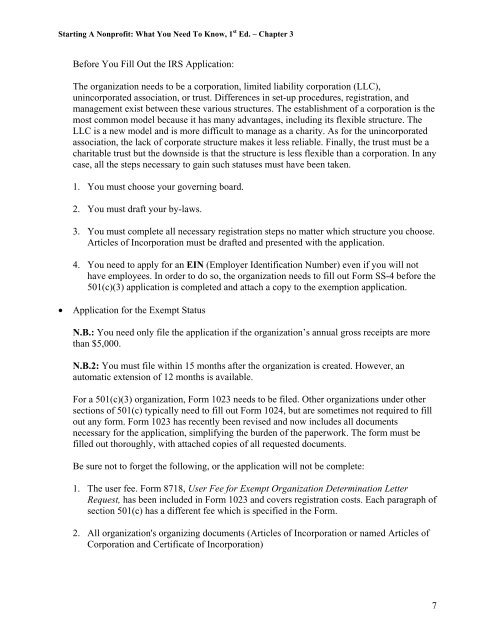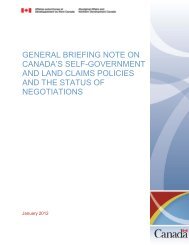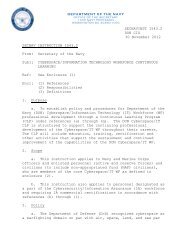HowToFormANonprofit_1st_ed-Chapter3
HowToFormANonprofit_1st_ed-Chapter3
HowToFormANonprofit_1st_ed-Chapter3
You also want an ePaper? Increase the reach of your titles
YUMPU automatically turns print PDFs into web optimized ePapers that Google loves.
Starting A Nonprofit: What You Ne<strong>ed</strong> To Know, 1 st Ed. – Chapter 3<br />
Before You Fill Out the IRS Application:<br />
The organization ne<strong>ed</strong>s to be a corporation, limit<strong>ed</strong> liability corporation (LLC),<br />
unincorporat<strong>ed</strong> association, or trust. Differences in set-up proc<strong>ed</strong>ures, registration, and<br />
management exist between these various structures. The establishment of a corporation is the<br />
most common model because it has many advantages, including its flexible structure. The<br />
LLC is a new model and is more difficult to manage as a charity. As for the unincorporat<strong>ed</strong><br />
association, the lack of corporate structure makes it less reliable. Finally, the trust must be a<br />
charitable trust but the downside is that the structure is less flexible than a corporation. In any<br />
case, all the steps necessary to gain such statuses must have been taken.<br />
1. You must choose your governing board.<br />
2. You must draft your by-laws.<br />
3. You must complete all necessary registration steps no matter which structure you choose.<br />
Articles of Incorporation must be draft<strong>ed</strong> and present<strong>ed</strong> with the application.<br />
4. You ne<strong>ed</strong> to apply for an EIN (Employer Identification Number) even if you will not<br />
have employees. In order to do so, the organization ne<strong>ed</strong>s to fill out Form SS-4 before the<br />
501(c)(3) application is complet<strong>ed</strong> and attach a copy to the exemption application.<br />
• Application for the Exempt Status<br />
N.B.: You ne<strong>ed</strong> only file the application if the organization’s annual gross receipts are more<br />
than $5,000.<br />
N.B.2: You must file within 15 months after the organization is creat<strong>ed</strong>. However, an<br />
automatic extension of 12 months is available.<br />
For a 501(c)(3) organization, Form 1023 ne<strong>ed</strong>s to be fil<strong>ed</strong>. Other organizations under other<br />
sections of 501(c) typically ne<strong>ed</strong> to fill out Form 1024, but are sometimes not requir<strong>ed</strong> to fill<br />
out any form. Form 1023 has recently been revis<strong>ed</strong> and now includes all documents<br />
necessary for the application, simplifying the burden of the paperwork. The form must be<br />
fill<strong>ed</strong> out thoroughly, with attach<strong>ed</strong> copies of all request<strong>ed</strong> documents.<br />
Be sure not to forget the following, or the application will not be complete:<br />
1. The user fee. Form 8718, User Fee for Exempt Organization Determination Letter<br />
Request, has been includ<strong>ed</strong> in Form 1023 and covers registration costs. Each paragraph of<br />
section 501(c) has a different fee which is specifi<strong>ed</strong> in the Form.<br />
2. All organization's organizing documents (Articles of Incorporation or nam<strong>ed</strong> Articles of<br />
Corporation and Certificate of Incorporation)<br />
7





